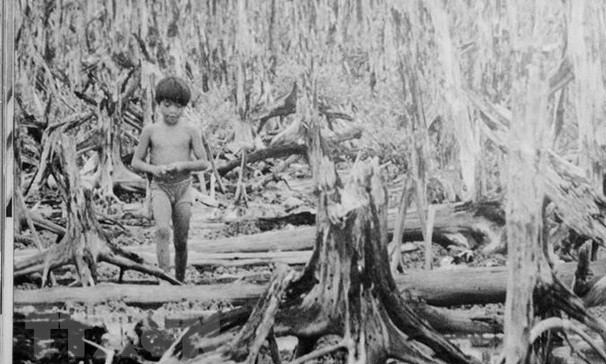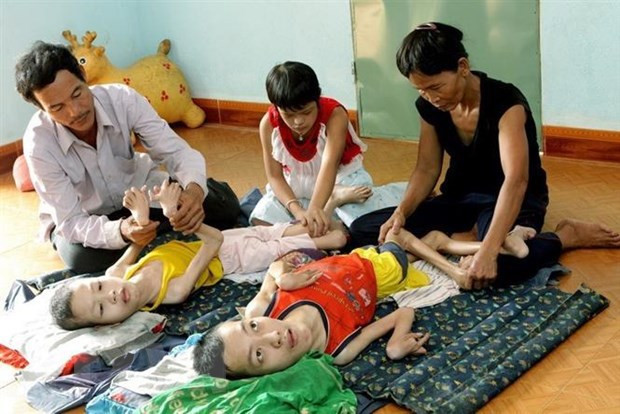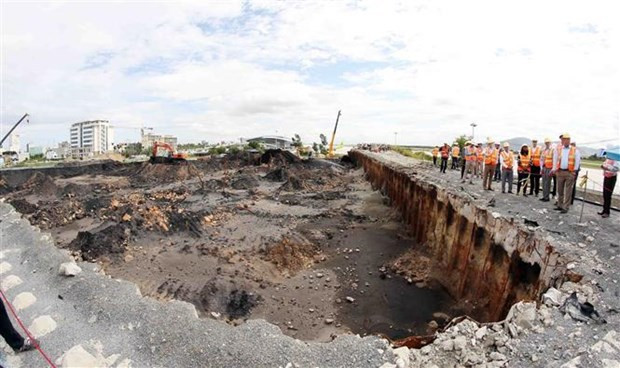 The impact of Agent Orange/dioxin that the US sprayed during the war in Vietnam still exists nowadays (File photo)
The impact of Agent Orange/dioxin that the US sprayed during the war in Vietnam still exists nowadays (File photo) About 4.8 million Vietnamese peoplehave been exposed to AO, and more than 3 million others who are their second,third, and even fourth generations have still suffered from pains and losseseven when the war ended nearly 50 years ago.
In 1961, then US President J. Kennedyauthorised chemical warfare, aside from the “hot war”, in Vietnam.
To conceal their plan from thepublic, the US Department of Defence used the code name “Operation Ranch Hand”and spread a false belief among US troops and people that the chemicals usedwere just normal herbicides and defoliants aimed to uncover the enemy’s hidingplaces and minimise casualties for the US army and its alliance’s troops, andthat they were not hazardous to animals and did not have considerable impact onhuman health.
However, it is a fact that thechemical warfare waged by the US in Vietnam was the largest and longest one causingthe most destructive consequences in human history.
 The family of Nguyen Huu Dong in Tien Chau commune of Tien Phuoc district, central Quang Nam province, has seven children suffering from after-effects of Agent Orange. They are one of the 200 families which have benefited from a cow farming project carried out by the US' War Legacies Project with support from Vietnam's Fund for Support to AO Victims since 2007 (Photo: VNA)
The family of Nguyen Huu Dong in Tien Chau commune of Tien Phuoc district, central Quang Nam province, has seven children suffering from after-effects of Agent Orange. They are one of the 200 families which have benefited from a cow farming project carried out by the US' War Legacies Project with support from Vietnam's Fund for Support to AO Victims since 2007 (Photo: VNA)This lead to severe environmentalpollution as seen in the undermined water storage and flood mitigationfunctions of forests, the biodiversityloss, the extinction of some rare fauna and flora species, and the mushroomingof rodents and weeds.
Nowadays, the toxic chemicals droppedby the US military are still present in some southern areas and have become sourcesof pollution.
At the second international workshopon the toxic chemicals used by the US in the Vietnam war and their impact onthe nature and human held in Hanoi in 1993, many Vietnamese and foreign scientistsaffirmed that those toxic chemicals destroyed the nature and human health andcaused many acute diseases and genetic mutations passed from mothers orfathers.
In July 2009, a report by the USInstitute of Medicine proved the links between the exposure to AO/dioxin andfive diseases, namely soft tissue sarcoma, benign lymphoma, chronic lymphocyticleukemia, cancer, and chloracne.
The Vietnamese Ministry of Health also confirmed 17 diseases, disorders,deformities, and malformations connected with AO/dioxin.
 A delegation of US parliamentarians led by Congressman Ted Yoho, head of the US House Foreign Affairs Sub-committee on Asia, the Pacific, and Nonproliferation, visits the site of the project on environmental remediation of dioxin contamination at the vicinity of Da Nang airport on October 17, 2017 (Photo: VNA)
A delegation of US parliamentarians led by Congressman Ted Yoho, head of the US House Foreign Affairs Sub-committee on Asia, the Pacific, and Nonproliferation, visits the site of the project on environmental remediation of dioxin contamination at the vicinity of Da Nang airport on October 17, 2017 (Photo: VNA)Not only Vietnamese but a largenumber of soldiers of the US, the Republic of Korea, Australia, and New Zealandwho used to fight in Vietnam and their descendants have also got many diseasescaused by the AO exposure and after-effects.
Admiral Elmo Zumwalt, Commander of theUS naval forces in Vietnam from 1968 to 1970, said at least 2,100 US soldiers were exposed to AO.
Meanwhile, the Republic of Korea’s associationof war veterans exposed to AO estimated that about 100,000 of the 300,000 Koreansoldiers fighting in Vietnam are victims of AO, more than 20,000 of them havedied.
Scientists believed that the impactof AO may last for hundreds of years and affect tens of millions of people, andthe number of generations suffering from after-effects will not be limited tofour, making the AO disaster the worst chemical one in human history./.





























